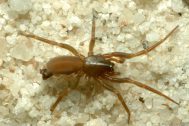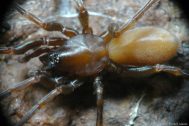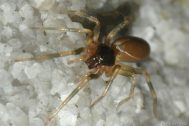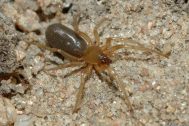| Nálezy podle období | |||||
|---|---|---|---|---|---|
| Dysderidae | 0-1900 | 1901-1950 | 1951-2000 | 2001+ | ∑ |
| Harpactea lepida (C. L. Koch, 1838) Není ohrožený | 4× | 13× | 954× | 289× | 1260× |
Harpactea lepida (C. L. Koch, 1838)
| České jméno | šestiočka obecná |
|---|---|
| Stupeň ohrožení | Není ohrožený |
| Nálezy | 1260 nálezů, 211 kvadrátů |
| První nález |
1838, C. L. Koch, Koch 1838 |
| Poslední nález | 2024 , Tomáš Kopecký |
| Areál rozšíření | European - Me. |
| Fytogeografická oblast |
|
| Původnost stanovišť |
|
| Vlhkost stanovišť |
|
| Stratum |
|
| Osvětlení stanovišť |
|
| Hojnost výskytu |
|
| Nadm. výška | 150-1350 |
Literatura
Invertebrates of the Macocha Abyss (Moravian Karst, Czech Republic).
The invertebrates of the Macocha Abyss, Moravian Karst, Czech Republic, were collected in 2007–2008 and 222 species were identified in total. The relative abundance of individual taxa of land snails, harvestmen, pseudoscorpions, spiders, millipedes, centipedes, terrestrial isopods, beetles, and ants was evaluated. The cold-adapted mountain and subterranean species inhabit the bottom and lower part of the abyss, whereas the sun-exposed rocky margins were inhabited by thermophilous species. Macocha harbors several threatened species that are absent or very rare in the surrounding habitats. In the forest landscape, the Macocha Abyss represents a natural habitat with a distinct microclimatic gradient, and is an excellent refuge area for psychrophilous as well as thermophilous species, which significantly contributes to maintenance of landscape biodiversity.
Spiders on sandstone rocks in Central Europe with particular reference to the Bohemian Switzerland National Park.
While the majority of the Central European landscape would be covered by forests without human influence, rocky areas form isolated, islet-like, natural, non-forest habitats. The surface of some of these non-forested areas is composed of bare bedrock or products of its erosional breakdown (without a soil layer) such as gravel, sand banks, sand dunes, scree slopes and rock outcrop habitats. These habitats harbour specialized spider species that depend on their specific substratum and microclimate (Růžička 2000). Out of these habitats, rock walls (and scree slopes) form one of the most distinct ecological gradients of any terrestrial ecosystem (Larson et al. 1989, Růžička et al. 1995). They provide habitats with extremely warm and cold microclimatic conditions in close proximity. They also belong to habitats almost unknown until now due to the technical and practical problems of sampling.
Sandstones can form extensive systems of rocks, sometimes with a broad spectrum of meso- and microhabitats due to their very dynamic relief. Sandstone rocks are characterised by a marked contrast between forested plateau and bare vertical rock walls (Balatka and Sládek 1984). Upper margins of rocks are dry, vertical rock walls can be sun-exposed, dry and bare, or shady and humid and hence covered by mosses. Spaces with an extremely cold climate can occur in deep gorges. The aim of this study is to evaluate available data on the species composition of spider assemblages in sandstone rocks, including new data about spiders on rock walls in the Bohemian Switzerland (České Švýcarsko) National Park.
Fotografie
Statistiky
Dle měsíce v roce
Dle nadmořské výšky
Dle metody sběru (1260 použitých nálezů)
| Harpactea lepida (C. L. Koch, 1838) ES | Samci | Samice | Mláďata | Nálezy |
|---|---|---|---|---|
| Zemní past | 1573 | 764 | 139 | 977 |
| Prosev | 32 | 59 | 50 | 57 |
| Individuální sběr | 58 | 29 | 14 | 51 |
| Neurčeno | 96 | 74 | 9 | 148 |
| Smyk | 40 | 24 | 0 | 20 |
| Eklektor | 1 | 1 | 1 | 3 |
| Sklepávání | 3 | 0 | 1 | 4 |
| Samci | Samice | Mláďata | Nálezy |
Dle biotopu (1260 použitých nálezů)
| Harpactea lepida (C. L. Koch, 1838) ES | Samci | Samice | Mláďata | Nálezy |
|---|---|---|---|---|
| Lesy | 11 | 7 | 0 | 69 |
| Horské smrčiny | 73 | 3 | 0 | 17 |
| Louky | 4 | 1 | 0 | 11 |
| Rašeliniště | 94 | 41 | 2 | 48 |
| Mokřady | 1 | 0 | 0 | 2 |
| Paseky | 14 | 3 | 0 | 16 |
| Suťové a roklinové lesy | 121 | 49 | 16 | 66 |
| Suché louky | 3 | 5 | 1 | 10 |
| Horské bučiny | 90 | 11 | 18 | 29 |
| Kamenolomy | 26 | 26 | 1 | 14 |
| Močály | 4 | 1 | 0 | 4 |
| Skály a sutě v horách | 0 | 5 | 3 | 3 |
| Reliktní bory na skalách | 6 | 1 | 8 | 10 |
| Vlhké lesní lemy | 0 | 0 | 1 | 1 |
| Lesy | 162 | 59 | 12 | 77 |
| Neurčeno | 243 | 165 | 63 | 275 |
| Bučiny nižších poloh | 262 | 130 | 2 | 110 |
| Dubohabřiny | 35 | 4 | 1 | 5 |
| Výsadby listnáčů | 4 | 4 | 0 | 4 |
| Vlhké doubravy | 1 | 0 | 0 | 1 |
| Jeskyně | 8 | 5 | 0 | 4 |
| Suché doubravy | 51 | 37 | 19 | 48 |
| Nehluboké podzemní prostory (pukliny, půdní horizonty) | 1 | 0 | 0 | 1 |
| Stinné skály nižších poloh | 167 | 110 | 17 | 59 |
| Kamenité suti nižších poloh | 77 | 59 | 8 | 66 |
| Výsadby jehličnanů | 107 | 62 | 12 | 92 |
| Rašelinné bory | 7 | 2 | 0 | 8 |
| Luční ostřicové mokřady | 8 | 8 | 1 | 6 |
| Přirozené lesy | 39 | 18 | 5 | 37 |
| Lesy vyšších poloh a strmých svahů | 51 | 29 | 4 | 46 |
| Břehy tekoucích vod | 44 | 18 | 0 | 30 |
| Interiéry budov | 2 | 1 | 0 | 1 |
| Porosty borůvek | 5 | 1 | 0 | 6 |
| Ruderály | 0 | 2 | 0 | 1 |
| Lužní lesy nížin | 10 | 3 | 1 | 4 |
| Ostřicové porosty stojatých vod | 0 | 1 | 0 | 1 |
| Lesní okraje | 2 | 6 | 1 | 7 |
| Skalní a suťové biotopy | 23 | 20 | 13 | 10 |
| Lesostepní doubravy | 9 | 12 | 0 | 11 |
| Skalní stepi na vápenci | 1 | 0 | 5 | 4 |
| Xerotermní travinobylinná společenstva | 5 | 1 | 0 | 6 |
| Mokré louky | 1 | 1 | 0 | 2 |
| Mokřadní olšiny | 3 | 3 | 0 | 5 |
| Podmáčené smrčiny | 5 | 13 | 0 | 9 |
| Acidofilní bory | 17 | 18 | 0 | 15 |
| Širokolisté horské nivy | 2 | 5 | 0 | 5 |
| Suché křoviny | 1 | 0 | 0 | 1 |
| Vrbové křoviny - vlhké (vrbové) křoviny | 1 | 0 | 0 | 1 |
| Polní biotopy | 1 | 0 | 0 | 1 |
| Horská vřesoviště | 1 | 1 | 0 | 1 |
| Samci | Samice | Mláďata | Nálezy |
















